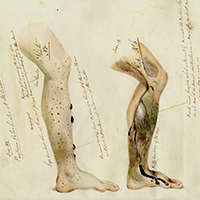Keywords
Scurvy, ascorbic acid, ecchymosis, psychiatric disease
Abstract
Scurvy was a common 18th century disease caused by vitamin C deficiency. It presents with multiple non-specific symptoms and can lead to capillary fragility due to impaired collagen synthesis. We report the case of a 63-year-old woman who presented with fatigue, nausea and progressive skin lesions consisting of multiple ecchymoses on the legs as also described in the diary drawings of a navy doctor in the 19th century. The ascorbic acid level was undetectable low in the patient’s serum. However, treatment with 500 mg ascorbic acid daily dramatically improved the skin lesions within 5 days.
References

Views: 1165
HTML downloads: 938
PDF downloads: 427
Figure2 downloads: 0
Conflict of interest downloads: 0
Conflict of interest2 downloads: 0
Copyright downloads: 0
Cover letter downloads: 0
Untitled downloads: 0
Published:
2015-10-19
Issue:
Vol. 2 No. 7 (2015)
(view)










